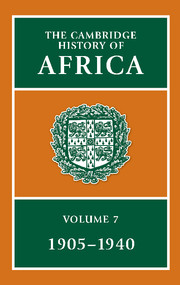Book contents
- Frontmatter
- Introduction
- 1 The imperial mind
- 2 Aspects of economic history
- 3 Christianity
- 4 Islam
- 5 African cross-currents
- 6 The Maghrib
- 7 French black Africa
- 8 British West Africa and Liberia
- 9 Belgian Africa
- 10 Portuguese Africa
- 11 Southern Africa
- 12 British Central Africa
- 13 East Africa
- 14 Ethiopia and the Horn
- 15 Egypt and the Anglo-Egyptian Sudan
- Bibliographical Essays
- Bibliography
- Index
- 10 West Africa from Senegal to Dahomey, 1935
- 13 Belgian Africa, 1939
- References
13 - East Africa
Published online by Cambridge University Press: 28 March 2008
- Frontmatter
- Introduction
- 1 The imperial mind
- 2 Aspects of economic history
- 3 Christianity
- 4 Islam
- 5 African cross-currents
- 6 The Maghrib
- 7 French black Africa
- 8 British West Africa and Liberia
- 9 Belgian Africa
- 10 Portuguese Africa
- 11 Southern Africa
- 12 British Central Africa
- 13 East Africa
- 14 Ethiopia and the Horn
- 15 Egypt and the Anglo-Egyptian Sudan
- Bibliographical Essays
- Bibliography
- Index
- 10 West Africa from Senegal to Dahomey, 1935
- 13 Belgian Africa, 1939
- References
Summary
By 1905, the British and the Germans had occupied several strategic points in East Africa. They were the latest of many intruders from overseas. The coast and the offshore islands had long shared in the commerce of the Indian Ocean. The expansion of trade in the nineteenth century quickened the flow of Arab immigrants and also prompted Indian traders to settle among the black, and mostly Muslim, Swahili-speakers of the East African littoral. The British government intervened in Zanzibar and up-country mainly to secure the western flank of its Indian empire: well into the twentieth century it continued to regard East Africa as an appendage to India. But both British and Germans also came to colonise the hinterland. The British had recently completed the Uganda Railway, which ran from Mombasa through scrub and desert to the temperate uplands south of Mount Kenya, across the great Rift Valley and down to the shores of Lake Victoria. The western part of this line skirted the populous countries of the Kikuyu and Luo, and lake steamers completed the link between the coast and the kingdom of Buganda. Here the scope of British initiative was constrained by an agreement reached in 1900 with a ruling elite already converted and educated by Christian missionaries. But either side of the Rift there were fertile and lightly occupied highlands which attracted white farmers, especially from South Africa, while British planters moved into western Uganda (the name used by the British for both Buganda and much of the surrounding territory). Meanwhile, German planters and farmers clustered round the hills of Uluguru and Usambara, and the lower slopes of Kilimanjaro.
- Type
- Chapter
- Information
- The Cambridge History of Africa , pp. 649 - 701Publisher: Cambridge University PressPrint publication year: 1986
References
- 2
- Cited by

